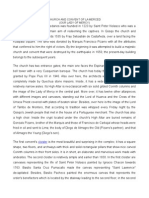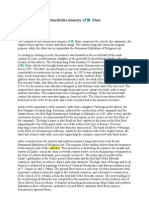Church and Convent of San Francisco (Saint Francis)
Church and Convent of San Francisco (Saint Francis)
Uploaded by
jesu4197Copyright:
Available Formats
Church and Convent of San Francisco (Saint Francis)
Church and Convent of San Francisco (Saint Francis)
Uploaded by
jesu4197Original Description:
Original Title
Copyright
Available Formats
Share this document
Did you find this document useful?
Is this content inappropriate?
Copyright:
Available Formats
Church and Convent of San Francisco (Saint Francis)
Church and Convent of San Francisco (Saint Francis)
Uploaded by
jesu4197Copyright:
Available Formats
CHURCH AND CONVENT OF SAN FRANCISCO
(SAINT FRANCIS)
The Franciscan Order was founded by Saint Francis native from Assisi in present-day Italy,
toward the beginning of XIII century. The Franciscans arrived to Qosqo by the first years of the
conquest and were located by the San Blas district, later in the Nazarenas Square, in the
ancient Qasana palace belonging to Inka Pachakuteq in the Main Square and finally in their
present-day location over the San Francisco Square toward 1549. It is not known who the
architect was that designed the present-time building; however, it is known that Francisco
Dominguez Chavez y Arellano, a Cusquenian architect who worked as the chief mason
finished it. The structure of the church is relatively simple and has just one tower and two
gates, but it is solid and made with andesites from pre-Hispanic buildings. Its original artworks
were destroyed by a priest that "modernized" the church with coarse neoclassical plastermade artworks. Its Major Altar is neoclassical and made in plaster having a Saint Francis of
Assisi effigy in the central part and above it is the Virgin of the Immaculate Conception. There
are also 11 other minor altarpieces, all of them made in plaster; it has an ancient cedar wood
pulpit too.
Its convent cloister is the oldest in the city and has a renaissance style with diverse influences.
It has an impressive ceiling decorated with painted panels. Over here is an enormous canvas
that is possibly the biggest in the continent measuring about 12 mts. (39 ft.) high and 9 mts.
(30 ft.) wide; it was painted by Juan Espinoza de los Monteros toward 1699. That painting
represents 12 branches of the Franciscan order containing 683 personages, 224 coats of arms
and 203 biography legends. What is also impressive is the church's high choir that was carved
in local cedar wood by Franciscans Fray Luis Montes, Isidro Fernandez Inka and Antonio de
Paz, by 1652. That choir contains images of 93 Saints of the Catholic Church; its lectern is
also very nice, and has an imposing German organ. More over, there are many more canvases
in the different rooms and cloisters; almost all of them anonymous from the Cusquenian
School of painting.
You might also like
- Church and Convent of La Merced (Our Lady of Mercy) : CloisterDocument2 pagesChurch and Convent of La Merced (Our Lady of Mercy) : Cloisterjesu4197No ratings yet
- Practical 6 Word 2020-21 Without FormatDocument4 pagesPractical 6 Word 2020-21 Without FormatJuan LinNo ratings yet
- Cusco CathedralDocument19 pagesCusco CathedraljulitopapichaNo ratings yet
- Santa Ana Church (Manila)Document5 pagesSanta Ana Church (Manila)Jason TiongcoNo ratings yet
- Hoa2 ReportingDocument4 pagesHoa2 ReportingDanisse LoiNo ratings yet
- St. Peter's Basilica, RomeDocument21 pagesSt. Peter's Basilica, RomeManh ThangNo ratings yet
- Santa MonicaDocument3 pagesSanta MonicaNaomi S. Ramos V.No ratings yet
- St. Peter's Basilica: History and ArchitectureDocument5 pagesSt. Peter's Basilica: History and ArchitectureJunnineTupazNo ratings yet
- About Pisa CathedralDocument5 pagesAbout Pisa CathedralSnow WhiteNo ratings yet
- Pisacathedralcomplexnew 230120113101 d5c8d7ffDocument19 pagesPisacathedralcomplexnew 230120113101 d5c8d7ffAde Iqbal PradhanaNo ratings yet
- The Path To God Francisco de Herrera The Elders WDocument21 pagesThe Path To God Francisco de Herrera The Elders WIman AshamNo ratings yet
- Welcome To The Cistercian Abbey of Heiligenkreuz!: History CourtyardDocument2 pagesWelcome To The Cistercian Abbey of Heiligenkreuz!: History CourtyardvivaNo ratings yet
- San Agustin Church ValueDocument2 pagesSan Agustin Church ValueEdzel QuijanoNo ratings yet
- Sistine Chapel 1Document30 pagesSistine Chapel 19tami SolankiNo ratings yet
- 009-Santa Maria in TrastevereDocument16 pages009-Santa Maria in TrastevereRoger SanNo ratings yet
- BaroqueDocument3 pagesBaroqueItz Me Gacha MoonlightNo ratings yet
- TibidaboDocument5 pagesTibidaboFilip BaruhNo ratings yet
- Renaissance Architecuure in Italy (Autosaved)Document25 pagesRenaissance Architecuure in Italy (Autosaved)preetiNo ratings yet
- Byzantine ArchitectureDocument2 pagesByzantine Architecturen.k.indiaNo ratings yet
- RenaissanceDocument29 pagesRenaissanceRuben FogarasNo ratings yet
- Architectural PresentationDocument9 pagesArchitectural PresentationKushagra ChawlaNo ratings yet
- Saint Peter'S BasilicaDocument3 pagesSaint Peter'S BasilicaEarl UbiñaNo ratings yet
- Basilica FactsDocument3 pagesBasilica FactsEarl UbiñaNo ratings yet
- Saint Peter'S BasilicaDocument3 pagesSaint Peter'S BasilicaLorenzNo ratings yet
- Hoa2 ReportingDocument3 pagesHoa2 ReportingDanisse LoiNo ratings yet
- Basilica of Saint Paul Outside The WallsDocument6 pagesBasilica of Saint Paul Outside The WallsJason TiongcoNo ratings yet
- Benedictine Nunnery of STDocument2 pagesBenedictine Nunnery of STKristijan MarićNo ratings yet
- Manila CathedralDocument5 pagesManila CathedralTrixia Mariz DimatulacNo ratings yet
- Presentación 14Document16 pagesPresentación 14hshauidhNo ratings yet
- Italian Gothic ArchitectureDocument6 pagesItalian Gothic ArchitectureAndree AndreeaNo ratings yet
- French Arcitechure Eg in Pondicherry InfoDocument17 pagesFrench Arcitechure Eg in Pondicherry InfoTishya PansariNo ratings yet
- Pisa CathedralDocument10 pagesPisa CathedralNidhi Mehta100% (1)
- Churches: Almudena CathedralDocument3 pagesChurches: Almudena CathedralAndrés AcPzNo ratings yet
- Buddhist Chaitas and ViharasDocument25 pagesBuddhist Chaitas and ViharasSumit SharmaNo ratings yet
- Renaissance Architecture 1205077832179104 3Document199 pagesRenaissance Architecture 1205077832179104 3JD CJO100% (1)
- St. Peter's BasilicaDocument5 pagesSt. Peter's BasilicaEarl UbiñaNo ratings yet
- Toledo Cathedral1Document2 pagesToledo Cathedral1HannahNo ratings yet
- Saint Peter BasilicaDocument2 pagesSaint Peter BasilicaSanic BardNo ratings yet
- St. Peter's Square (: Ovato TondoDocument19 pagesSt. Peter's Square (: Ovato TondoFelix Albit Ogabang IiiNo ratings yet
- Church ArchitectureDocument62 pagesChurch ArchitectureRaychel MalonNo ratings yet
- Presentation PisaDocument17 pagesPresentation PisaroshanNo ratings yet
- BAROQUE ARCHITECTURE - Giacomo Della Porta, Francesco Borromini, Gian Lorenzo Bernini and Their WorksDocument11 pagesBAROQUE ARCHITECTURE - Giacomo Della Porta, Francesco Borromini, Gian Lorenzo Bernini and Their WorksAnqa ParvezNo ratings yet
- Ficuzza: A Fig Tree That Was Born From That Has Been Magically ReproducingDocument35 pagesFicuzza: A Fig Tree That Was Born From That Has Been Magically Reproducingvoglia100% (1)
- Romanesque ArchitectureDocument7 pagesRomanesque ArchitectureNiharikaNo ratings yet
- Chatzidakis Hosios LoukasDocument96 pagesChatzidakis Hosios Loukasamadgearu100% (4)
- The Importance History of Sto. Nino de Anda Parish ChurchDocument2 pagesThe Importance History of Sto. Nino de Anda Parish ChurchRogelio Olasos BernobaNo ratings yet
- The Importance History of Sto. Nino de Anda Parish ChurchDocument2 pagesThe Importance History of Sto. Nino de Anda Parish ChurchRogelio Olasos BernobaNo ratings yet
- St. Lucy Church HistoryDocument2 pagesSt. Lucy Church HistoryDan DanNo ratings yet
- Catedral de GironaDocument10 pagesCatedral de GironaQueralt Boixadé PalahíNo ratings yet
- El BaldaquinoDocument4 pagesEl BaldaquinoluisjorgelopezbarreraNo ratings yet
- Baroque & Roccoco Architecture: A Lecture by Tanushree Das Date: 06.03.2014Document43 pagesBaroque & Roccoco Architecture: A Lecture by Tanushree Das Date: 06.03.2014T Aruna PugalenthiNo ratings yet
- Manila Architecture 2nd and 3rd DistrictDocument45 pagesManila Architecture 2nd and 3rd DistrictDonna Oliit ÜNo ratings yet
- Košice: St. Elisabeth's CathedralDocument11 pagesKošice: St. Elisabeth's CathedralmoljkaNo ratings yet
- Art Orientation CH 15 9th Ed OnlineDocument48 pagesArt Orientation CH 15 9th Ed OnlineNguyễn Đức ÝNo ratings yet
- Piazza Dei Miracoli English VersionDocument3 pagesPiazza Dei Miracoli English VersionpiccolistoriciNo ratings yet
- Santo Domingo ChurchDocument6 pagesSanto Domingo ChurchJason TiongcoNo ratings yet
- The Development of Visual Arts in The PhilippinesDocument5 pagesThe Development of Visual Arts in The PhilippinesGrecel Ann Latoja LacambraNo ratings yet



























































